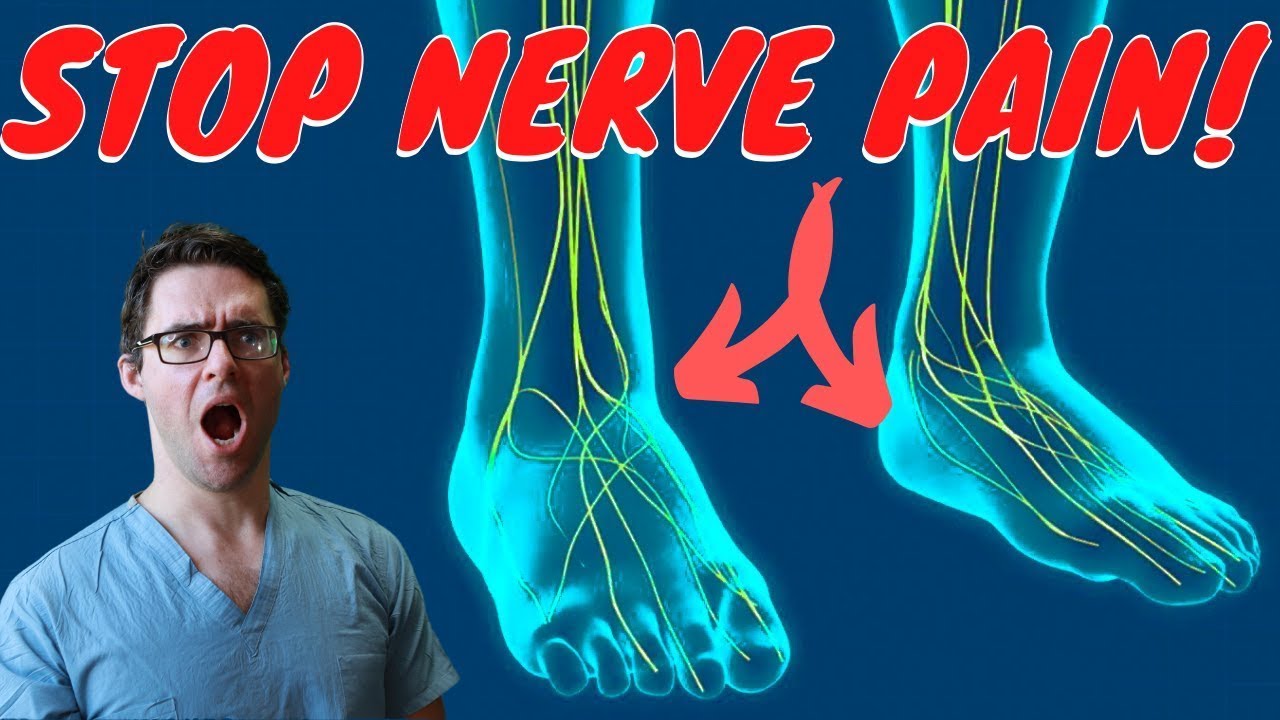Baxter’s Nerve Entrapment Heel Pain [ Pinched Heel Nerve Treatment]
Baxter’s nerve entrapment can be a prevalent cause of heel pain. We go over the 100% best treatment options and products to get this fix FAST!
Baxter’s Nerve Entrapment Treatment, Exercises & Stretches Video:
Relief for baxter’s nerve entrapment video summary:
This video goes over:
- What is Baxter’s nerve entrapment?
- Baxter’s nerve entrapment treatment.
- Baxter’s nerve entrapment exercises.
- Baxter’s nerve entrapment stretches.
- Baxter’s nerve injections.
- Baxter’s nerve surgery.
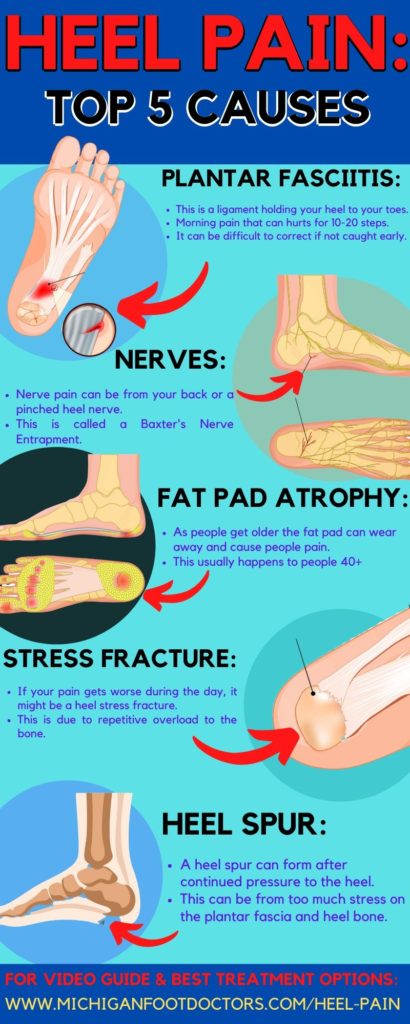
Heel Pain Causes: Picture & Photo Gallery
Look:
- One of the top causes of heel pain is plantar fasciitis. This is damage to a ligament that holds your heel to your toes.
- Another root cause of heel pain has flat feet.
- There are also photos of heel spurs that can occur to the bottom of your heel (plantar fascia insertion) and the back of your heel (Achilles tendon insertion).
- Baxter’s nerve entrapment can also happen at the bottom of the heel.
- An underlying cause is an overpronated flatfoot or an over a supinated high arched foot.
- A plantar fibroma is a thick nodule that can occur within your plantar fascia ligament and contribute to plantar fasciitis.
- This can lead to the formation of a heel stress fracture( AKA calcaneus stress fracture.)
Please click on the gallery for a guided tour through heel pain conditions!
6 Common Causes of Heel Pain:
1) Plantar fasciitis is the most common one:
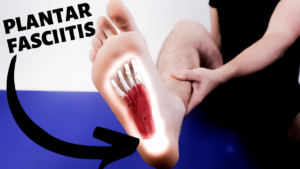
- It is said that 10-40% of people in the world will have chronic heel pain.
- 93% of that is said to be plantar fasciitis.
- This is the most common cause of heel pain in the world.
- It is said that 44% of all foot clinic visits are related to a combination of plantar fasciitis.
- If you have a bottom of the foot and heel pain during the morning, this is likely plantar fasciitis!
- This usually gets better after 10-20 morning steps but then hurts the next morning.
2) Achilles Tendinitis & Back of the Heel Pain:
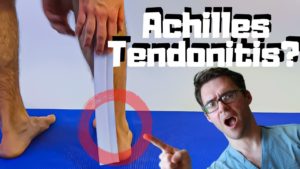
- This is the most common cause of pain in the back of the heel. It is possible to develop heel spur and rest soreness at the site of the Achilles tendon inserts.
- It is also possible to have it about 2 to 6 cm above the heel bone (Called the middle of the Achilles tendon pain).
- It is also possible to strain the actual calf muscle, but Achilles tendinitis is not heel pain.
- This is perhaps the most important ended in the body in terms of bearing weight.
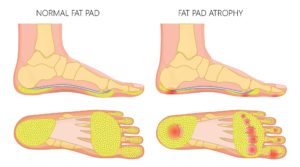
- Common in older people common and those who have had steroid injections, it is thought that he can start at 40, but it does continue later in life.
- We see this most commonly in much older people such as the 60s, 70s, 80s, and higher.
- If you are younger, it is doubtful that this is your problem.
- This is usually achy, burning pain that gets worse during the day.
- This is a prevalent condition that we see overall, and it does need to be treated effectively!
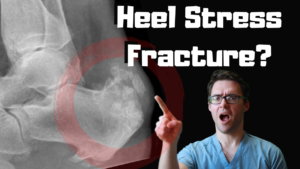
- This is increased pain while you are bearing weight.
- These are typical during running sports and repetitive shocked heels.
- It is tested by checking side to side squeeze of the heel bone.
- The calcaneal squeeze test is crucial in confirming that heel stress fractures.
- Click on the above link to make sure this is not your problem!
5) Radiculopathy (Back Pain):
- If you have ever had a back injury or nerve injury to your spine, you may have radiculopathy pain.
- This can cause numbness, burning, and tingling-type pain.
- We see this very commonly in people who have soreness and pain in both feet.
- If you have a prior back injury or surgery, this may be your problem.
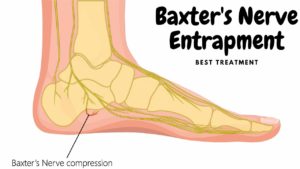
- Baxter’s nerve compression and entrapment is not the most common cause of heel nerve pain.
- Some sources even say Baxter’s nerve compression can be involved in up to 20% of heel pain cases!
- This can result in more nighttime pain, as well as pain during rest.
- If you have numbness, burning, and tingling, it may be Baxter’s pinched nerve in the heel!
How Common Is Baxter’s Nerve entrapment?
- Baxter’s nerve compression and entrapment is not the most common cause of heel nerve pain.
- Some sources even say Baxter’s nerve compression can be involved in up to 20% of heel pain cases!
- It is said that between 10 to 40% of people will suffer from chronic heel pain throughout their lives. Roughly 90% of that heel pain is something called plantar fasciitis.
- But that means that in America alone, almost 30 million people are suffering from other causes of heel pain!
- One such cause of this is nerve compression between the plantar fascia, the heel bones, associated muscles in the floor.
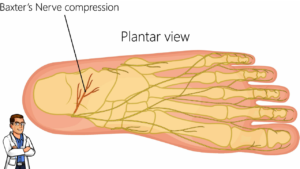
What Is Baxter’s Nerve Entrapment:
- Baxter’s nerve entrapment is also known as distal tarsal tunnel syndrome.
- From an anatomical standpoint, it is the entrapment of the first branch of the lateral plantar nerve. This is thought to be due to the heel spur in the plantar fascia band that gets entrapped. Also involved can be the abductor hallucis brevis.
- It’s rare, which is probably the best reason to regard it as its own condition rather than a cause of plantar fasciitis.
- But when it occurs, it is often mistaken for plantar fasciitis.
- It can be a common reason why plantar fasciitis is not getting better and stays chronic plantar fasciitis pain.
Two Sites of Nerve Entrapment:
Two sites of nerve entrapment:
- the first of the most common site is between the abductor hallucis and quadratus Plantae muscles.
- The second site is aware that nerve passes underneath the heel bone.
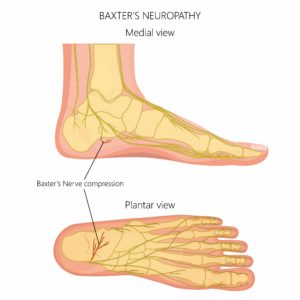
Baxter’s Nerve Anatomy:
- The nerve runs vertically between the abductor hallucis in the quadratus Plantae muscles.
- It then makes a 90° horizontal turn beneath the heel bone to enervate the abductor digiti minimi the muscle.
Baxter’s Nerve Symptoms:
The Baxter’s nerve is the first branch of the lateral plantar nerve. It can become entrapped underneath the heel.
Baxter’s nerve entrapment can result in pinched nerve heel pain:
- numbness, burning, tingling, and a strange feeling sensation at the bottom of your field. This is known as paresthesia.
- The bottom inside of your heel can also feel tender.
- This type of heel pain is more likely to cause night-time pain and pain during the day.
- When the nerve is compressed, the symptoms may look a lot like plantar fasciitis.
Who gets Baxter’s nerve compression?
Medial calcaneal nerve entrapment is most commonly seen in:
- People who stand on their feet all day: nurses, teachers, factory workers, and other hard-working professionals.
- Athletes such as sprinters, dancers, and gymnasts are frequently on their toes.
What muscle causes the trapped nerve in the heel:
- This is because you have a developed muscle called the abductor hallucis muscle: this can compress
the lateral plantar nerve. - It can also be involved with the plantar fascia heel spur of the plantar fascia ligament.

Baxter’s Nerve Entrapment Treatment:
- The best treatments are to cool down inflammation first: this can include anti-inflammatory pills, icing, elevating, and resting your foot.
- Massaging techniques can also help decrease the swelling of the abductor hallucis muscle and swelling in the bottom of the foot.
- The key is to keep that swelling from ever coming back.
- What’s the initial wave of inflammation is down. This is when it makes sense to stretch and massage the muscle more.
- The second phase of treatment is to continue to keep pressure off of it: this includes great shoes, great foot orthotics and insoles, and potentially an anti-inflammatory injection.
- We recommend starting treating similar plantar fasciitis and see how this goes.
- Below is our common plantar fasciitis treatment.
Baxter’s nerve entrapment stretches:
- We believe the stretches for your Baxter’s nerve entrapment are an excellent treatment strategy.
- The first thing we want to do is decrease the soreness and inflammation of Baxter’s nerve and the bottom of your heel.
- Think about a broken ankle. For example, the swelling and the soreness need to calm down first before you begin stretches & exercises.
- This is true for Baxter’s nerve entrapment as well.
- First, we would recommend focusing on icing and anti-inflammatory treatments and limiting the new damage being created.
- Baxter’s nerve entrapment would initially be best served with good shoes, good orthotics, and potentially a brace.
- Once the soreness starts to decrease, you can begin stretching your calf muscles, your plantar fascia your hamstring.
- Watch the video above for our favorite Baxter’s nerve entrapment stretches.
Baxter’s nerve entrapment exercises:
- Just like Baxter’s nerve entrapment stretches, we find a lot of benefits Baxter’s nerve entrapment exercises.
- Strengthening your thigh muscles the calf muscles in your hamstrings can go a long way towards taking pressure off the foot, the ankle, and hip.
- Above, we go into specific detail and show you how to perform Baxter’s nerve entrapment exercises.
- See the video above for favorite exercises for Baxter’s nerve entrapment.
Baxter’s nerve injection:
- We are a big fan of Baxter’s nerve injections.
- This is a fairly low-risk treatment modality.
- In a can have good overall improvement for your Baxter’s nerve entrapment pain.
- Click the link for our guide to foot cortisone injections to find out more.
Relief for Baxter’s nerve entrapment:
- Our favorite relief for Baxter’s nerve entrapment is Baxter’s nerve cortisone injection.
- This can help diagnose whether entrapment is taking place and whether an injection there can get better.
Physical therapy for Baxter’s nerve entrapment:
- We are big fans of physical therapy for Baxter’s nerve entrapment.
- Because this is a targeted inflammation problem, a treatment like Baxter’s nerve injection may be beneficial initially.
- But as the soreness starts to come down, Baxter’s nerve physical therapy treatment program may be very beneficial.
Baxter’s Nerve Surgery:
- Surgery can result in the release of the abductor hallucis muscle or neurolysis of the nerve.
- This means killing the nerve.
- The results have been reported to be 90% successful.
- Baxter’s nerve surgery can be very beneficial and have good results.
- Luckily, we rarely need to have people pursue Baxter’s nerve surgery.
- We believe that with good treatment options and non-surgical options above, it is possible to have excellent results.
- This is also known as Baxter’s nerve decompression surgery.
Baxter’s nerve surgery recovery time:
- The average surgical recovery time for Baxter’s nerve entrapment can take about 2 weeks for the initial soreness in the incision site to improve.
- It can then take an extra 4-6 weeks for about 50% of the soreness and pain to
- go away.
- We usually tell patients that at about 3 months, they should be at over 75% of the final expected outcome.
- At about 6 months, it is expected to be at about 90% of the outcome.
- And at about 1 year, it is close to 100% of the expected outcome.

